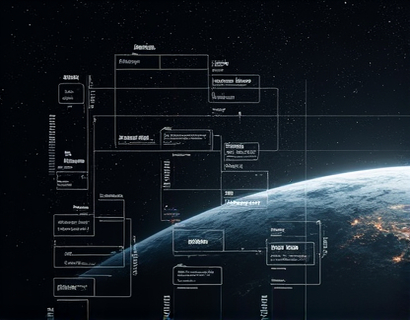Agricultural Software: Revolutionizing Farming with Tailored Tech for Enhanced Efficiency and Productivity
In recent years, the agricultural sector has witnessed a significant transformation driven by advanced software solutions. These technologies are not just augmenting traditional farming practices but are fundamentally reshaping the way farming businesses and professionals operate. The integration of sophisticated software systems is leading to enhanced operational efficiency, improved data management, and more informed decision-making processes. This article delves into the various ways agricultural software is revolutionizing the farming industry, providing a comprehensive overview of the tools and technologies that are making a difference.
The Evolution of Agricultural Technology
The journey of agricultural technology, or agritech, dates back to the early 20th century with the introduction of mechanized farming equipment. However, the modern era of agritech began with the advent of computers and the internet, which opened up new possibilities for data collection, analysis, and communication. Initially, these technologies were primarily used for basic tasks such as record-keeping and inventory management. Over time, the scope expanded to include more complex applications like precision farming, remote sensing, and automated machinery.
Today, agricultural software encompasses a wide range of tools designed to address specific challenges faced by farmers and agricultural businesses. These solutions leverage advancements in areas such as artificial intelligence, machine learning, IoT (Internet of Things), and big data analytics to provide tailored solutions that enhance productivity and sustainability. The evolution of these technologies has been driven by the need for more efficient and data-driven farming practices, which are essential in a world facing increasing population growth and resource scarcity.
Streamlined Processes through Automation
One of the most significant impacts of agricultural software is the automation of routine tasks, which frees up time for farmers and agricultural professionals to focus on more strategic activities. Automation in farming can be seen in various forms, from automated irrigation systems to robotic harvesters. These technologies not only reduce the physical labor required but also minimize human errors and inconsistencies.
For instance, automated irrigation systems use sensors to monitor soil moisture levels and weather conditions, adjusting water usage in real-time to optimize plant growth while conserving water resources. Similarly, robotic harvesters equipped with computer vision and machine learning algorithms can identify and pick ripe fruits and vegetables with precision, reducing waste and increasing efficiency. These automated solutions are particularly beneficial in large-scale farming operations where manual labor is both costly and inefficient.
Improved Data Management and Analytics
Data is the backbone of modern agriculture, and agricultural software plays a crucial role in managing and analyzing this data effectively. With the proliferation of IoT devices, farmers can now collect vast amounts of data from various sources, including soil sensors, weather stations, and machinery. This data, when aggregated and analyzed, provides valuable insights that can inform decision-making and optimize farm operations.
Agricultural software platforms offer robust data management capabilities, allowing users to store, organize, and access data seamlessly. These platforms often include features such as data visualization tools, which help users interpret complex data sets through intuitive graphs and charts. For example, a farmer can use a dashboard to monitor crop health, track yield trends, and identify areas that require attention. This level of data transparency and accessibility is transformative, enabling farmers to make data-driven decisions that enhance productivity and reduce costs.
Informed Decision-Making with Predictive Analytics
Predictive analytics is a powerful tool within agricultural software that helps farmers anticipate and prepare for future challenges. By analyzing historical data and current trends, these systems can forecast weather patterns, pest infestations, and crop yields with a high degree of accuracy. This foresight allows farmers to take proactive measures, such as adjusting planting schedules, applying pesticides preemptively, or diversifying crop varieties to mitigate risks.
For instance, a predictive analytics model can analyze weather data to predict the likelihood of drought conditions in a specific region. Based on these predictions, farmers can implement water-saving measures or choose drought-resistant crop varieties. Similarly, by monitoring pest activity patterns, farmers can apply targeted pest control measures, reducing the need for broad-spectrum chemicals and minimizing environmental impact. These data-driven insights not only improve operational efficiency but also contribute to more sustainable farming practices.
Precision Farming and Variable Rate Technology
Precision farming, also known as precision agriculture, is a methodology that uses technology to optimize field-level management regarding crop farming. At the core of precision farming is variable rate technology (VRT), which allows for the precise application of inputs such as seeds, fertilizers, and pesticides based on the specific needs of different areas within a field.
Agricultural software supports precision farming by integrating data from GPS, soil sensors, and drones to create detailed maps of field conditions. These maps are used to generate prescription maps that guide machinery in applying the right amount of inputs in the right locations. This approach not only maximizes resource utilization but also minimizes environmental impact by reducing over-application. For example, a farmer can use VRT to apply fertilizer only where it is needed, based on soil nutrient levels, thereby saving costs and reducing runoff into waterways.
Moreover, precision farming enables real-time monitoring and adjustment of farming operations. Drone technology, when combined with software analytics, can provide high-resolution images of fields, allowing farmers to identify issues such as nutrient deficiencies, pest infestations, or water stress. This real-time feedback loop ensures that corrective actions can be taken promptly, further enhancing crop health and yield.
Supply Chain Optimization
Beyond the farm itself, agricultural software is also transforming the supply chain, from production to distribution. Efficient supply chain management is critical for ensuring that produce reaches consumers fresh and in optimal condition. Software solutions in this domain help streamline logistics, reduce waste, and improve overall efficiency.
One key application is in inventory management, where software can track the movement of goods in real-time, from the farm to the retailer. This visibility helps in maintaining optimal stock levels, reducing spoilage, and ensuring that products are delivered on time. For instance, a distribution center can use software to monitor the temperature and humidity of stored produce, adjusting conditions as needed to preserve quality.
Additionally, agricultural software can facilitate better communication and coordination between different stakeholders in the supply chain, such as farmers, processors, and retailers. Platforms that integrate data from various sources can provide a comprehensive view of the supply chain, enabling stakeholders to identify bottlenecks and optimize processes. This level of integration and transparency is essential for building resilient and efficient supply chains in the face of global challenges such as climate change and market volatility.
Sustainability and Environmental Impact
The environmental impact of agriculture is a growing concern, and agricultural software is playing a pivotal role in promoting sustainable farming practices. By providing tools for precise resource management, these technologies help reduce the environmental footprint of farming operations.
For example, precision irrigation systems not only conserve water but also reduce energy consumption by minimizing the use of pumps and other equipment. Similarly, variable rate application of fertilizers and pesticides ensures that these chemicals are used only where necessary, reducing runoff and soil contamination. This targeted approach not only benefits the environment but also lowers costs for farmers.
Moreover, agricultural software can help farmers adopt regenerative practices that enhance soil health and biodiversity. By analyzing soil data and providing recommendations for cover cropping, crop rotation, and organic amendments, these tools support practices that build soil fertility and resilience. This shift towards more sustainable practices is crucial for ensuring the long-term viability of agricultural systems in the face of climate change and resource depletion.
Challenges and Considerations
While the benefits of agricultural software are clear, there are several challenges and considerations that need to be addressed to ensure successful adoption. One of the primary barriers is the cost of implementing these technologies, which can be prohibitive for small-scale farmers. However, as the technology matures and becomes more widespread, costs are expected to decrease, making these solutions more accessible.
Another challenge is the need for technical expertise to effectively use and maintain these systems. Training and support are essential to help farmers and agricultural professionals navigate the complexities of agricultural software. Additionally, data privacy and security are critical concerns, as the collection and storage of sensitive farm data require robust security measures to prevent breaches and misuse.
Despite these challenges, the potential benefits of agricultural software are driving widespread adoption. Governments and organizations are increasingly recognizing the importance of agritech and are providing support through subsidies, training programs, and research initiatives. As the agricultural sector continues to evolve, the role of software in enhancing efficiency, productivity, and sustainability will only become more significant.
Conclusion
The integration of advanced software solutions in agriculture is revolutionizing the way farming is conducted, offering numerous benefits that extend beyond individual farms to the broader agricultural ecosystem. From streamlining processes and improving data management to enabling informed decision-making and promoting sustainability, agricultural software is a key driver of innovation in the farming industry. As technology continues to advance, the potential for further transformation is immense, promising a future where farming is more efficient, productive, and environmentally friendly.










































